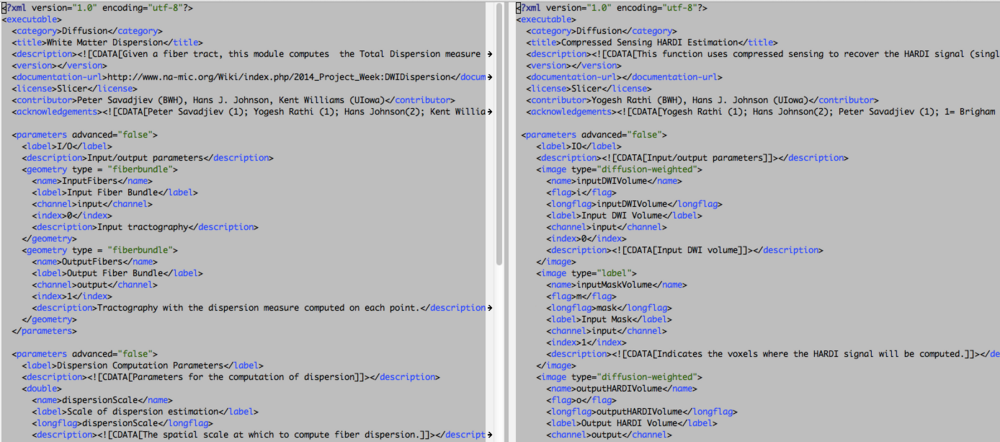Difference between revisions of "2014 Project Week:DWIDispersion"
From NAMIC Wiki
| (9 intermediate revisions by 2 users not shown) | |||
| Line 1: | Line 1: | ||
==Key Investigators== | ==Key Investigators== | ||
* Iowa: Hans Johnson | * Iowa: Hans Johnson | ||
| + | * Iowa: Kent Williams | ||
* BWH: C-F Westin | * BWH: C-F Westin | ||
* BWH: Peter Savadjiev | * BWH: Peter Savadjiev | ||
| Line 9: | Line 10: | ||
<div style="width: 27%; float: left; padding-right: 3%;"> | <div style="width: 27%; float: left; padding-right: 3%;"> | ||
<h3>Objective</h3> | <h3>Objective</h3> | ||
| − | Implement the fiber dispersion computation method of Savadjiev et al. (2012) as | + | Implement the fiber dispersion computation method of Savadjiev et al. (MICCAI 2012) and the compressed sensing HARDI estimation method of Rathi et al. as Slicer4 extensions. Convert the currently existing Matlab implementation into C++/ITK and test it on various datasets. |
</div> | </div> | ||
<div style="width: 27%; float: left; padding-right: 3%;"> | <div style="width: 27%; float: left; padding-right: 3%;"> | ||
<h3>Approach, Plan</h3> | <h3>Approach, Plan</h3> | ||
| − | * Create a realistic test suite based on | + | * Create a realistic test suite based on Huntington datasets for the Matlab code. |
| + | ** [HANS - Monday] Prepare test DWI data set for preparing data | ||
* Create a VTK reader/writer in matlab, in order to the test the matlab code. | * Create a VTK reader/writer in matlab, in order to the test the matlab code. | ||
| + | ** [KENT -- DONE] git@github.com:BRAINSia/CompressedSensingDWI.git | ||
| + | ** [PETER - DONE] Build github version of readers/writers | ||
| + | ** [PETER - DONE] Manually test vtk readers/writers, and convert existing test to use the binary forms | ||
| + | |||
* Convert the Matlab code to C++/ITK | * Convert the Matlab code to C++/ITK | ||
| + | ** [HANS/PETER - DONE] Create design document (i.e. this page and paer/pencil) to describe the intended inputs and outputs. | ||
| + | ** [PETER -- DONE] - Write desired command line interface psuedocode "caluclateDispersion --inputTract <wholebrain.vtp> --mask <roi.nrrd> --outputTract <decoratedversionofinput.vtp> " | ||
| + | ** [HANS/PETER -- DONE] - Create shell program in psydocode/comments with XML and cxx files with description of basic IO programming needed | ||
| + | ** [KENT -- Tuesday/Wednesday] -- Fill in I/O portions of psuedocode and make a compilable application that reads the inputTract, breaks it apart into necessary algorithmic components, and writes out the outputTract. | ||
*Create a Slicer extension | *Create a Slicer extension | ||
</div> | </div> | ||
| − | <div style="width: | + | </div> |
| + | |||
| + | <div style="margin: 20px;"> | ||
| + | <div style="width: 95%; float: left; padding-right: 3%;"> | ||
<h3>Progress</h3> | <h3>Progress</h3> | ||
| − | * | + | * Private git repository created at: git@github.com:BRAINSia/CompressedSensingDWI.git |
| + | * Spent time debugging the vtk readers/writers for MATLAB, in order to test the MATLAB code. | ||
| + | * Wrote XML interfaces for the fiber tract dispersion extension, and for the compressed sensing HARDI estimation. | ||
| + | [[File:DWIDispersion_xml_interfaces.png||1000px]] | ||
| + | * Next steps: continue debugging the vtk readers/writers for MATLAB, and begin translating the algorithm implementation from MATLAB to C++. | ||
</div> | </div> | ||
</div> | </div> | ||
Latest revision as of 15:34, 10 January 2014
Home < 2014 Project Week:DWIDispersionKey Investigators
- Iowa: Hans Johnson
- Iowa: Kent Williams
- BWH: C-F Westin
- BWH: Peter Savadjiev
Project Description
Objective
Implement the fiber dispersion computation method of Savadjiev et al. (MICCAI 2012) and the compressed sensing HARDI estimation method of Rathi et al. as Slicer4 extensions. Convert the currently existing Matlab implementation into C++/ITK and test it on various datasets.
Approach, Plan
- Create a realistic test suite based on Huntington datasets for the Matlab code.
- [HANS - Monday] Prepare test DWI data set for preparing data
- Create a VTK reader/writer in matlab, in order to the test the matlab code.
- [KENT -- DONE] git@github.com:BRAINSia/CompressedSensingDWI.git
- [PETER - DONE] Build github version of readers/writers
- [PETER - DONE] Manually test vtk readers/writers, and convert existing test to use the binary forms
- Convert the Matlab code to C++/ITK
- [HANS/PETER - DONE] Create design document (i.e. this page and paer/pencil) to describe the intended inputs and outputs.
- [PETER -- DONE] - Write desired command line interface psuedocode "caluclateDispersion --inputTract <wholebrain.vtp> --mask <roi.nrrd> --outputTract <decoratedversionofinput.vtp> "
- [HANS/PETER -- DONE] - Create shell program in psydocode/comments with XML and cxx files with description of basic IO programming needed
- [KENT -- Tuesday/Wednesday] -- Fill in I/O portions of psuedocode and make a compilable application that reads the inputTract, breaks it apart into necessary algorithmic components, and writes out the outputTract.
- Create a Slicer extension
Progress
- Private git repository created at: git@github.com:BRAINSia/CompressedSensingDWI.git
- Spent time debugging the vtk readers/writers for MATLAB, in order to test the MATLAB code.
- Wrote XML interfaces for the fiber tract dispersion extension, and for the compressed sensing HARDI estimation.
- Next steps: continue debugging the vtk readers/writers for MATLAB, and begin translating the algorithm implementation from MATLAB to C++.
